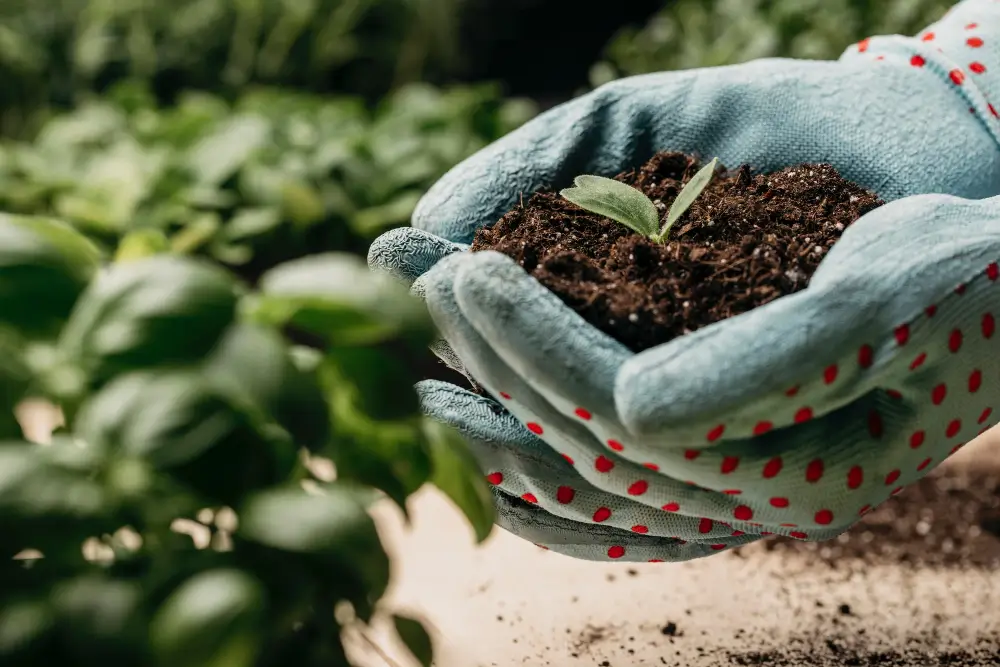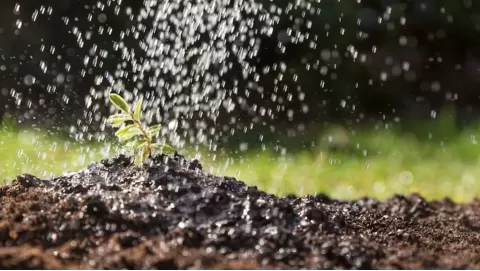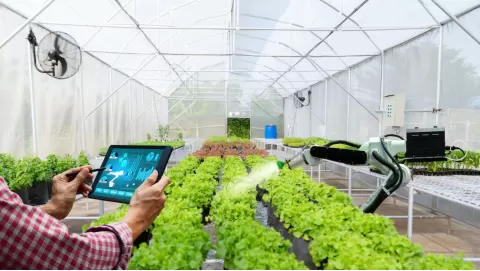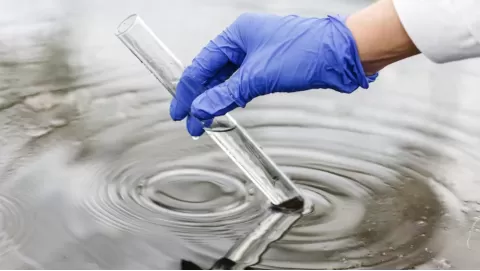
Understanding the impact of fertilizers on the nitrogen cycle: What you need to know
Nitrogen makes up a key part of amino acids, proteins and nucleic acid, DNA and RNA so it is essential for life on Earth. A crucial biogeochemical process cycle provides the basics where nitrogen is converted into numerous nitrogenous compounds to support life, increase soil fertility, stabilize ecosystems, and maintain environmental factors.
Initially, nitrogen was created inside stars by way of a process of nuclear fission and pumped out as nitrogen-bearing gases during the explosions of those ancient stars. Subsequently, as the planet developed, nitrogen became an essential aspect of the landmass, because of this nitrogen cycle stemming from the act of microbes.
The old farmers understood the significance of the nitrogen cycle. They served to sow leguminous crops that increase nitrogen-fixing bacteria, enriching crop yields and soil. But, during the 19th century, scientists identified the chemical nature of nitrogen, its importance for plant nutrition and the methods of increasing its availability in the soil. They also learned about the process that enables nitrogen-fixing bacteria and the way of enhancing their production and understanding the process of nitrification and denitrification.
During the 20th century, industrial fixation of atmospheric nitrogen by the Haber Bosch process became available. Only later, in the middle of the last century, was it realized that human activity is the main driver of the nitrogen cycle. Likewise, biased use of artificial fertilizers was also found to cause algal bloom and depleted oxygen in bodies of water due to nutritional deficiency or runoffs.
Today, a lot of research is being carried out to incorporate sustainable farming practices like crop rotation and organic farming to maintain the nitrogen inputs and outputs balance in the environment and soil.
Growcycle has been significantly helping growers effectively manage the nitrogen cycle, providing them with advanced tools and nitrogen based fertilizers.
Nitrogen stabilizers were introduced to slow the conversion of nitrogen and controlled-release fertilizers in the market to meet the plant's needs to maintain adequate nitrogen in the soil. They provide the use of organic and eco-friendly nitrogen products, and they suggest growers adopt the 4R formula, where the right source, time, rate, and place are the correct steps for better outcomes.
Importance of Nitrogen For Plant Growth
Nitrogen is essential to plant physiology and development because it is a key nutrient that encourages plant growth. It is an essential component of protein. As an enzyme , it can catalyse the various biochemical reactions in the body of the plant. It also helps with chlorophyll production, which is essential for photosynthesis. The sunlight, in turn, creates energy that feeds a multitude of daily reactions that plants perform in order to grow.
Nitrogen, too, is a building block of DNA and RNA and is important for passing genetic information on through generations. It helps in the growth of the leaves and stems of the plants, and a good nitrogen source will nourish and promote growth. Now, flowers, fruits, and seeds in plants strongly depend on proper nitrogen supply for high-yielding production and good quality plant growth.
In addition to these, nitrogen is responsible for maintaining abiotic stress during conditions such as the extreme weather of floods, droughts, and extreme temperatures. It is also central to resistance to disease and plant immunity. It is called so because if a plant lacks nitrogen, it becomes purple in color due to chlorosis, the yellowing of leaves. It also stunts the plant and decreases crop yield.
Key Stages of the Nitrogen Cycle
Stages in the nitrogen cycle, which is essential for the conversion of nitrogen into usable forms for plants.
Nitrogen Fixation
This is the first stage of the nitrogen cycle, which also involves converting the nitrogen into ammonia through certain types of bacteria and in the presence of an enzyme called nitrogenase. The most frequently employed bacteria are Rhizobium in root nodules of legumes and Azotobacter in soil.
However, in industrial nitrogen fixation, fairly high-pressure ammonia is produced using an iron catalyst through the combination and compression of atmospheric nitrogen and oxygen. Nitrogen can also be fixed when it combines with oxygen, with which it can bind when they are broken together in photochemical reactions or through lightning; the resulting nitrogen oxides then return to soil after being dissolved by rainwater.
Nitrification
In the first stage, the bacteria and fungi, like all decomposers, break down the dead parts of the plants and animals, like dead leaves and dead cells, and then reconvert some of this organic nitrogen created from organic matter into ammonia or, in some cases reserves of ammonium. But it doesn’t just stop here, urease-producing bacteria take in organic waste from plants and animals and convert it into ammonia and carbon dioxide. So ureolysis is the term for the process that converts urea into ammonia.
Assimilation
In this stage, the plant absorbs the nitrogen from the soil in the form of nitrates and ammonia and uses it to build protein, amino acids, and nucleic acids. In this stage, mycorrhizal fungi play a key role because they create a symbiotic relationship with the plant, improving the surface area of the plant root system and boosting the nitrogen absorption from the soil, leading to a healthier plant and getting desired nutrients for itself.
Ammonification
In the first stage, the bacteria and fungi, like all decomposers, break down the dead parts of the plants and animals, like dead leaves and dead cells, and then reconvert some of this organic nitrogen created from organic matter into ammonia or, in some cases reserves of ammonium. But it doesn’t just stop here, urease-producing bacteria take in organic waste from plants and animals and convert it into ammonia and carbon dioxide. So ureolysis is the term for the process that converts urea into ammonia.
Denitrification
If there is no oxygen in the soil or if the environment is poor in oxygen supply, the denitrifying bacteria reduce the nitrates back to nitrogen gas and release it into the atmosphere. This is how they avoid soil pollution, eutrophication, and the accumulation of nitrates in the ground.
Natural Sources of Nitrogen in Soil
All sources of nitrogen compounds have crucial importance in the Nitrogen cycle and nitrogen in soil originates from various sources. Soil nitrogen is absorbed by plants or bacteria from the air as gas Nitrogen, however plants and bacteria convert this Nitrogen into useful ammonia and related compounds to absorb it for energy. Nitrogen can include soluble N through assimilation of ammonia in rainwater, or it can become atmospheric N, manufactured by a lightning process that converts it into various forms of ammonia and nitrate.
Decomposers also play an important role in converting nitrogen gas into ammonia through the decomposition process, which is absorbed into the soil and utilized by living organisms. Decomposition from both the urine and the excrement of the animal produces Nitrogen and gets absorbed into the soil through soil microbes.
Dust and ash, which exist in the form of wind particles that fall on the earth, contain Nitrogen, which ultimately adds to soil nitrogen. In addition, the volcanic eruptions and the association of plants to nitrogen-fixing bacteria (N, P, K, Fe, etc.), as well as the biomass and roots of alfalfa or clover, which exude Nitrogen to the soil.
Role of Microorganisms in the Nitrogen Cycle
Microorganisms are nature’s little movers of nitrogen across ecosystems, bringing nitrogen from one medium into another.Their role in the nitrogen cycle starts at the first step when Rhizobium and other cyanobacteria convert atmospheric nitrogen into ammonia.
Once atmospheric nitrogen is transferred into the soil, nitrification is again completed by Nitrosomonas and Nitrobacter that convert ammonia to absorbable nitrogen for plants. Microorganisms are responsible for the nitrogen balance in the environment, which makes this element available for living organisms and stabilizes ecosystem functions.
Types of Fertilizers with Nitrogen Content
There are different kinds of fertilizers with nitrogen, all suitable to various plants as well as soil types. Some common nitrogen fertilizers include:
Ammonium Nitrate (NH4NO3)
Nitrogen Content: 34-35%
This fertilizer is extremely potent and easily absorbed by plants. It acts fast, and it lasts a long time.
Urea (CO(NH2)2)
Nitrogen Content: 46%
Urea Nitrogen fertilizer is one of the most commonly used nitrogen fertilizers owing to its high nitrogen content. It is soluble in water and can be applied directly to soil.
Ammonium Sulfate ((NH4)2SO4)
Nitrogen Content: 21%
This is critical for the plant growth as it provides Nitrogen and Sulfur. Has lower nitrogen content than urea and ammonium nitrate and adds sulfur to the soil.
Calcium Nitrate (Ca(NO3)2)
Nitrogen Content: 15-17%
This fertilizer gives plants a source of calcium and nitrogen. It is readily soluble in water and quickly taken up by plants, so it is useful for crops that require a high rate of calcium.
Anhydrous Ammonia (NH3)
Nitrogen Content: 82%
Anhydrous ammonia is applied in gas form by inserting the machine all the way into the soil. With the best nitrogen content, it is also the most commonly used fertilizer for large farms.
Sodium Nitrate (NaNO3)
Nitrogen Content: 16%
Also called Chilean nitrate, this natural fertilizer is great for dry areas. It provides plants with readily available nitrogen in the form of nitrate.
Ammonium Phosphate ((NH4)3PO4)
Nitrogen Content: Around 11-13%
It also brings some nitrogen and phosphorus nutrients required for the early stage of plant development. It is also commonly used on crops that need both nutrients to grow.
How Fertilizers Affect The Nitrogen Cycle?
By dissolving, rich nitrogen across the ground, fertilizers have a major effect on the nitrogen cycle, and their utilization brings changes in environmental outcomes:
1. Nitrogen Addition to Soil
Urea and ammonium nitrate are examples of rich nitrogen-based fertilizers; they release nitrogen in the soil and make it available for plants, which use it for quick and vigorous growth. The increased nitrogen content also plays a good role in assisting the plants in protein formation on soil. Conversely, the eutrophication phenomenon also takes place through runoff of fertilizers to the body of water, contributing to the growth of algae and weeds as well as causing disturbance in the environmental oxygen levels.
2. Changes in Soil Microbial Activity
Use of fertilizers disrupts the natural ecosystem of soil microorganisms. While synthetic fertilizers benefit nitrifying bacteria for nitrification processes, organic matter will support the growth of decomposers to generate the nutrient cycle.
Imbalance and imbalance of one will influence the second microorganism's growth and balance the microbial activity, affecting the nutrient cycle and soil health.
3. Environmental Impact
Excess nitrogen in fertilizer can leach into groundwater or wash into nearby waterways. This may lead to contamination of water, such as algal blooms, which use oxygen in the water, thus having negative effects on the life of water animals.
During the process of nitrification (and denitrification), nitrogen-based fertilizers can escape to the atmosphere and be released as the potent greenhouse gas nitrous oxide.
4. Impact on Natural Nitrogen Fixation Process
Overuse of synthetic fertilisers can interrupt natural nitrogen fixation. Excess nitrogen from fertilizers pushes the time the plants rely on natural resources, as it meets their requirements from the synthetic supply. It inhibits the action of fixed nitrogen bacteria. A slow performance will be obtained, for example, due to a crop rotational phenomenon and other natural processes, relying on the natural fixation.
5. Plant and Crop Impact
In the short term, the extra nitrogen bolstered growth and yields, as nitrogen fertilizers do. Other nutrient inequalities affect soil health, and many diseases are the result of nutrient deficiencies.
Positive Effects of Fertilizer Use
Fertilizers increase soil microbial activities, aiding in the decay of organic matter and nutrient recycling, improving soil structure, and healthier soil communities with more resilient crops. Similar to organic fertilizers, compost and manure enhance soil aeration, increase water retention capacity and root penetration, minimize soil erosion, and nourish plants.
They enable soil to bind better with roots and supply the plant with nutrients more evenly and efficiently. So, the vegetables and fruits develop rapidly, progressively, and also enhance the minerals and vitamins of vegetables and fruits. It increases crop yield in existing farmlands without disrupting existing diversity and natural ecosystems. They also enhance carbon sequestration, which allows the soil to potentially store large amounts of carbon dioxide and use it during plant growth, lowering the chance of having issues because of climate change.
The fertilization increases the crops, and plants use water, leading to decreased continuous irrigation leading to savings in the budget, time, etc. They also encourage the presence of beneficial insects, such as earthworms and beetles, leading to pest control and great pollination of plants.
Negative Effects of Fertilizer Use
Overuse of fertilizer leads to soil acidification, thus increasing acidity and metal leaching that can be toxic to plant roots. Excess application of nitrogen-rich fertilizers leaches potential greenhouse gases, including nitrous oxide, which has a 300-times higher global warming potential than carbon dioxide.
Eutrophication and water pollution, causing algal blooms, also occur due to algae overgrowth. These blooms create dead zones for aquatic life, where aquatic life becomes dead, which means it can’t survive.
Excessive fertilizers destroy human health and the balance of microbes in the soil, which causes the soil to become infertile with time. It can lead to more diseases and pests, stress plants’ growth, and reduce soil organic matter.
Soil compaction from excessive fertilizer application also reduces soil pore spaces, resulting in poor root growth and less air in the soil. This over-prescribing also increases farmers' costs in farm operations.
Best Practices For Sustainable Fertilizer Use
In this way, the natural formation of soil and healthy soil formation are maintained with the average and proper use of fertilizers. Here are some important practices for it:
- Knowing the soil’s natural nutrient level, pH, organic matter, and other contaminants helps farmers choose appropriate fertilizers as per composition. Taking soil samples from various depths and locations can test to the quality of your land, so you can choose which crops to rotate and how much fertilizer to apply, based on soil needs.
- Before planting, there is a recommendation to apply fertilizers to ensure a good start. Split methods may be a good treatment to maintain a balanced nutrient distribution, as they were applied during the wet season, which should lead to less leaching/runoff.
- Preventing leaching and runoff is the true purpose of coated and naturally slow-releasing fertilizers, keeping nutrients available over time so that plants can continue to grow. Likewise, organic fertilizers tend to be better for soil structure and the activity of microbes.
- Crop rotation is a technique that can make plants more immune to pests and disease attacks and helps balance the structure of the soil. Hence, farmers should opt for crop families to help maintain a balanced and healthy soil. Legumes and grasses, among others, used as cover crops before and after harvest, can prevent soil erosion and enhance the nitrogen cycle.
- Sensors provide real-time monitoring of soil moisture, temperature and nutrient level, which can guide accurate fertilizer application, and GPS-guided equipment can map the real-time location of nutrient deficiency.
Alternatives To Traditional Fertilizers
Alternatives to traditional fertilizers can naturally improve soil health, and their environmental impacts are not as harsh as chemical fertilizers, support sustainability in farming practices, and prove cost-effective; some of the important alternatives are:
- Biological Nitrogen Fixation
The best soil conditioners are leguminous plants, like peas, beans, and clover, as a result of that they kind symbiotic relations with nitrogen-fixing bacteria and use atmospheric nitrogen for his or her vitality, which shrink the dependence on synthetic fertilizers. Cover crops are also used for soil erosion prevention as well as nutrient storage in the structure of the soil for other plants.
- Compost and Vermicompost
Compost, like decomposed materials, improves water retention and boosts microbial activity for enhanced nitrogen recycling. Vermicompost also decomposes the organic matter to enhance soil texture, micronutrient supply, and soil aeration. It also encourages the proliferation of beneficial microorganisms.
- Biochar and Other Soil Amendments
Crop residues and wood are used to produce biochar. Used as a soil amendment, it increases fertility, reduces soil acidity, and enhances water retention. Lime, rock phosphate, and gypsum are other common soil amendments.
- Integrated Nutrient Management Approaches
Ultimately, using a combination of organic and inorganic fertilizers, improved nitrogen cycling using crop rotation and cover crops, careful monitoring of the soil structure, and using the needed fertilizers will improve management techniques and have a lower impact on the structure of the environment.
FAQS
Are there any household items I can use as natural nitrogen fertilizers?
You may use few things from the kitchen like used coffee powder, excess water from boiled vegetables, banana skins, grasses cut from the garden and egg shells. Some examples of rich nitrogen, safe for plants.
How can I calculate the right amount of fertilizer for my garden size?
To calculate the amount of fertilizer you need by square feet, you need to know the total garden area you have. After the measurement, the soil test result is verified, and the following amount of fertilizer is used for 1000 sq feet. For those who have not reported soil tests, measuring 2-4 pounds of nitrogen for a 1000 square feet area is recommended.
Are there any risks to pets or children from commonly used nitrogen fertilizers?
Nitrogen, phosphorus, and potassium — chemicals that make up the most commonly used nitrogen fertilizers — can hurt pets and kids. Pets that ingest such chemicals may have diarrhea, vomiting, and skin irritation. The fertilizers may contain poison, which may also act on children in a similar manner.
The Bottom Line
The nitrogen cycle is highly crucial to sustaining life on Earth, but excessive nitrogen leads to significant plant health issues along with soil and environmental destruction. To avoid problems, biochar is also recommended as it reduces nitrogen leaching and increases the soil nutrient retention capacity.
Microbial inoculants perform a similar function by enhancing nutrient uptake to prevent failures while reducing the use of synthetic fertilisers. Moreover, the micro-dosing of fertilizers enhances the efficiency of nutrient use on a limited budget and minimizes environmental impacts.
Growcycle offers affordable essential tools, products, and services that every gardener needs for soil preparation, management, plant growing, harvesting, and storage. They provide different customized fertilizers for the healthy growth of the plants, like fish emulsions, organic compost, vermicompost, and bone meal. They guide the user at every step from soil testing, gardening tips, to harvesting.
Disclaimer: This material is for informational purposes only and should not be relied on for legal, medical, financial, or other professional advice.





















